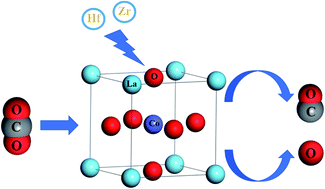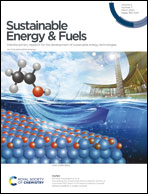Effectiveness of Zr and Hf incorporation into LaCoO3 towards fast and thermodynamically favorable solar thermochemical CO production studied with density functional theory
Abstract
As prominent oxygen carriers for the solar thermochemical (STC) cycle, the current Co-based perovskites suffer from a low CO production rate and CO2-to-CO conversion ratio. To enhance the above performance metrics, the adsorption and dissociation processes of CO2 on the LaCoO3(010) defect surface are studied. A transition state with a high activation energy (Ea) of 66.8 kJ mol−1 is determined at the CO2-splitting step, leading to the slow CO production by the LaCoO3-based system. However, we find that Ea could be reduced to 51.3 and 52.9 kJ mol−1 with 12.5% Zr and Hf doped at the B position of LaCoO3, as a result of which the CO2-splitting rate could increase up to 8 and 6.4 times at T = 900 K. Meanwhile, the results of the Gibbs free energy change indicate that LaCo0.875Zr0.125O3 and LaCo0.875Hf0.125O3 feature a larger thermodynamic driving force of CO2-splitting. In addition, the Hf dopant is also favorable for oxygen vacancy formation of LaCoO3. Our results demonstrate the feasibility of LaCo0.875Hf0.125O3 for fast STC CO production with high solar-to-fuel efficiency.



 Please wait while we load your content...
Please wait while we load your content...